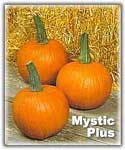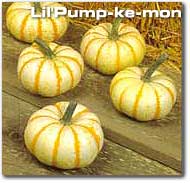February 2001
|
|
 If
you are in the pumpkin business you know how fickle a market it can be. If
you are in the pumpkin business you know how fickle a market it can be.
Do you opt for a mini "decorative" pumpkin? Or do you choose a more traditional
jack o'lantern - the kind with that dark rich orange color that has become a
Harris Moran hallmark?
Or, do you go bigger and plant a 35-60 pound behemoth?
Weighty questions indeed.
The answer depends on what your market demands, what your customer wants and if
you sell through a roadside stand or to a chain store.
Growing pumpkins begins with selecting a variety. This guide is designed to make
that decision easier. We've tossed in a few growing tips as well. |
 The
right variety for you The
right variety for you
 Selecting
pumpkin varieties that meet your market and customer needs is
crucial. Harris Moran offers many features of pumpkins to fill all
market slots. In addition to having various shapes and sizes,
Harris Moran varieties feature pumpkins with that dark rich color,
strong handles and disease resistances that enhance the appearance
and value of the pumpkin. Selecting
pumpkin varieties that meet your market and customer needs is
crucial. Harris Moran offers many features of pumpkins to fill all
market slots. In addition to having various shapes and sizes,
Harris Moran varieties feature pumpkins with that dark rich color,
strong handles and disease resistances that enhance the appearance
and value of the pumpkin.
Consult the chart below for the
right varieties for you. |
|
SIZE |
VARIETY |
SHAPE |
COLOR |
WEIGHT |
| Very
large |
Howden
Biggie |
upright
to round |
deep
orange |
35-60 |
| Large |
Howden |
deep
round |
deep
orange |
20-30 |
| Medium |
Magic
Lantern*
Merlin* |
slightly
upright
slightly upright |
dark
orange
rich orange |
16-24
15-25 |
| Small |
Mystic
Plus* |
round
to upright |
dark
orange |
5-7 |
| Mini |
Lil'Ironsides
Lil'Pump-ke-mon
Munchkin |
round,
slightly flat
flattened
flattened, scalloped |
bright
orange
white w/distinct stripes
medium orange |
1.5-2
1-2
0.5 |
|
|
*Indicates Powdery
Mildew tolerant variety |
|
| Fertility
|
|
 After you've made your selection,
it's time to plant. Before planting, sample the soil. An ideal pH
ranges from 6.0 to 7.0 You may need to amend your soil to achieve
this level with high calcium and low magnesium limestone, as your
soil test warrants. After you've made your selection,
it's time to plant. Before planting, sample the soil. An ideal pH
ranges from 6.0 to 7.0 You may need to amend your soil to achieve
this level with high calcium and low magnesium limestone, as your
soil test warrants.
 Once you have the proper pH, you
should apply the major soil nutrients (NPK) at the proper levels.
Don't forget the minor nutrients. Minor nutrients like calcium,
sulfur, magnesium, and boron are important for influencing color,
handle strength, and other qualities of a marketable pumpkin. Once you have the proper pH, you
should apply the major soil nutrients (NPK) at the proper levels.
Don't forget the minor nutrients. Minor nutrients like calcium,
sulfur, magnesium, and boron are important for influencing color,
handle strength, and other qualities of a marketable pumpkin. |

|
|
| Pollination
 Pumpkins sport both male and female
flowers. The plants must be insect pollinated - honeybees being
the main pollinators. Multiple visits to each flower are necessary
for pollination Ð about 15 visits per flower. Pumpkins sport both male and female
flowers. The plants must be insect pollinated - honeybees being
the main pollinators. Multiple visits to each flower are necessary
for pollination Ð about 15 visits per flower.
 The best placement for beehives is
in the production field. Place beehives in the field when flowers
begin opening, usually when the third node forms on the plant.
Leave beehives in the field for only 35 days. The best placement for beehives is
in the production field. Place beehives in the field when flowers
begin opening, usually when the third node forms on the plant.
Leave beehives in the field for only 35 days.
|

 Location and timing of pollination
is key because research shows honeybees prefer other types
of plants from which they get more nectar and pollen. Keep
the bees interested in pollinating the pumpkin patch by placing
the hives in the proper area at the proper time. Location and timing of pollination
is key because research shows honeybees prefer other types
of plants from which they get more nectar and pollen. Keep
the bees interested in pollinating the pumpkin patch by placing
the hives in the proper area at the proper time.
|
|
| Planting
and spacing
 Proper soil depth at planting,
along with spacing intervals, can also make or break a crop.
Recommended planting dates usually run from late May to early
July, depending on your location. You may want to consider
multiple planting dates to provide pumpkins for an extended
harvest period. Proper soil depth at planting,
along with spacing intervals, can also make or break a crop.
Recommended planting dates usually run from late May to early
July, depending on your location. You may want to consider
multiple planting dates to provide pumpkins for an extended
harvest period.
 Seeds are most often planted at a
depth of 1 to 2 inches depending upon the soil moisture at the
time of planting. Remember, you need good seed-to-soil contact for
optimum germination. Seeds are most often planted at a
depth of 1 to 2 inches depending upon the soil moisture at the
time of planting. Remember, you need good seed-to-soil contact for
optimum germination.
 Seeding rates per acre, as well as
spacing, should be selected based upon the variety of pumpkin.
Each variety has an ideal spacing for optimum performance. A heavy
stand can stress your plant and restrict growth thus influencing
the size and set of your pumpkins. Seeding rates per acre, as well as
spacing, should be selected based upon the variety of pumpkin.
Each variety has an ideal spacing for optimum performance. A heavy
stand can stress your plant and restrict growth thus influencing
the size and set of your pumpkins.
|
 In
work done by Ron Morse, Virginia
Polytechnic Institute & University, optimum yield was achieved
by using a semi-bush type plant such as
Magic Lantern and
equilateral spacing (4ft x 4ft). This type of spacing produced 25%
more marketable pumpkins than other spacings with the same number
of square feet (8ft x 2ft). (see
complete
article) In
work done by Ron Morse, Virginia
Polytechnic Institute & University, optimum yield was achieved
by using a semi-bush type plant such as
Magic Lantern and
equilateral spacing (4ft x 4ft). This type of spacing produced 25%
more marketable pumpkins than other spacings with the same number
of square feet (8ft x 2ft). (see
complete
article)
 Additionally, many growers produce
pumpkins using no-tillage cultural practices. One benefit of
no-till is the pumpkins will be cleaner and less susceptible to
rot because they are not in direct contact with the bare ground.
Hairy vetch and cereal grains can be used as cover crops for
no-till pumpkin production. The chart below highlights some
recommended spacing for each category. Additionally, many growers produce
pumpkins using no-tillage cultural practices. One benefit of
no-till is the pumpkins will be cleaner and less susceptible to
rot because they are not in direct contact with the bare ground.
Hairy vetch and cereal grains can be used as cover crops for
no-till pumpkin production. The chart below highlights some
recommended spacing for each category.
|
|
SIZE |
VARIETY |
BEETWEEN
ROW (ft) |
IN-ROW
(ft) |
SQ.FT. |
|
Very
large |
Howden
Biggie |
12-15 |
3-4 |
36-60 |
|
Large |
Howden |
8-12 |
3-4 |
24-48 |
|
Medium |
Magic
Lantern*
Merlin* |
3-4 |
4-5 |
12-24 |
|
Small |
Mystic
Plus* |
5-6 |
2-3 |
10-18 |
|
Mini |
Lil'Ironsides
Lil'Pump-ke-mon
Munchkin |
5-6 |
1-2 |
5-12 |
|
|
Managing
pests in your production field
|
|
There are three major pests that
need to be controlled to produce a successful pumpkin crop:
 Weeds can prevent bees
from pollinating flowers. They also serve as hosts for insects
which can spread harmful viruses Weeds can prevent bees
from pollinating flowers. They also serve as hosts for insects
which can spread harmful viruses
 Insects can introduce
viruses to a field. These infestations lead to restriction of
size, greening and lumpiness of the pumpkin fruit. Insects can introduce
viruses to a field. These infestations lead to restriction of
size, greening and lumpiness of the pumpkin fruit.
 Diseases can jeopardize
your pumpkin crop. Phytophthora Blight, Black Rot, Mosaic Viruses
and Powdery Mildew are just some of the major diseases that can do
you harm. Diseases can jeopardize
your pumpkin crop. Phytophthora Blight, Black Rot, Mosaic Viruses
and Powdery Mildew are just some of the major diseases that can do
you harm.
|
Each of these pests can be
controlled by numerous methods including: good crop rotation, soil
drainage, varietal resistance, proper planting time, seeding rate,
and regular use of pesticides.
 |
|
|
Harvest,
handling, and storing pumpkins
|
 If you want maximum tonnage from
your pumpkin crop, it is imperative you harvest your fruit at its
optimum maturity. If pumpkins are left on the vine past maturity
they will actually decrease in weight as each day passes. This can
reduce the final tonnage of your field. If you want maximum tonnage from
your pumpkin crop, it is imperative you harvest your fruit at its
optimum maturity. If pumpkins are left on the vine past maturity
they will actually decrease in weight as each day passes. This can
reduce the final tonnage of your field.
 When harvesting for wholesale be
sure to harvest and stack the pumpkins carefully in the bins so
you don't injure the fruit. Injured fruit offer the perfect points
of entry for post-harvest disease. When harvesting for wholesale be
sure to harvest and stack the pumpkins carefully in the bins so
you don't injure the fruit. Injured fruit offer the perfect points
of entry for post-harvest disease.

|
 The USDA
Agriculture Handbook suggests the following steps be taken
for proper pumpkin storage: The USDA
Agriculture Handbook suggests the following steps be taken
for proper pumpkin storage:
- Ideal storage temp should be
between 50 to 55 degrees F
- Relative humidity should be no
more than 70% and no less than 50%
- The harvested pumpkins should be
placed on racks, in bins, or baskets
- Stored in some type of common
storage building
 The Handbook also
states that pumpkins are susceptible to chilling injury at low
temperatures. There also appears to be differences among
varieties. The Handbook also
states that pumpkins are susceptible to chilling injury at low
temperatures. There also appears to be differences among
varieties.
Follow these guidelilnes and your
pumpkin crop should be a successful one.
|
|
|
|